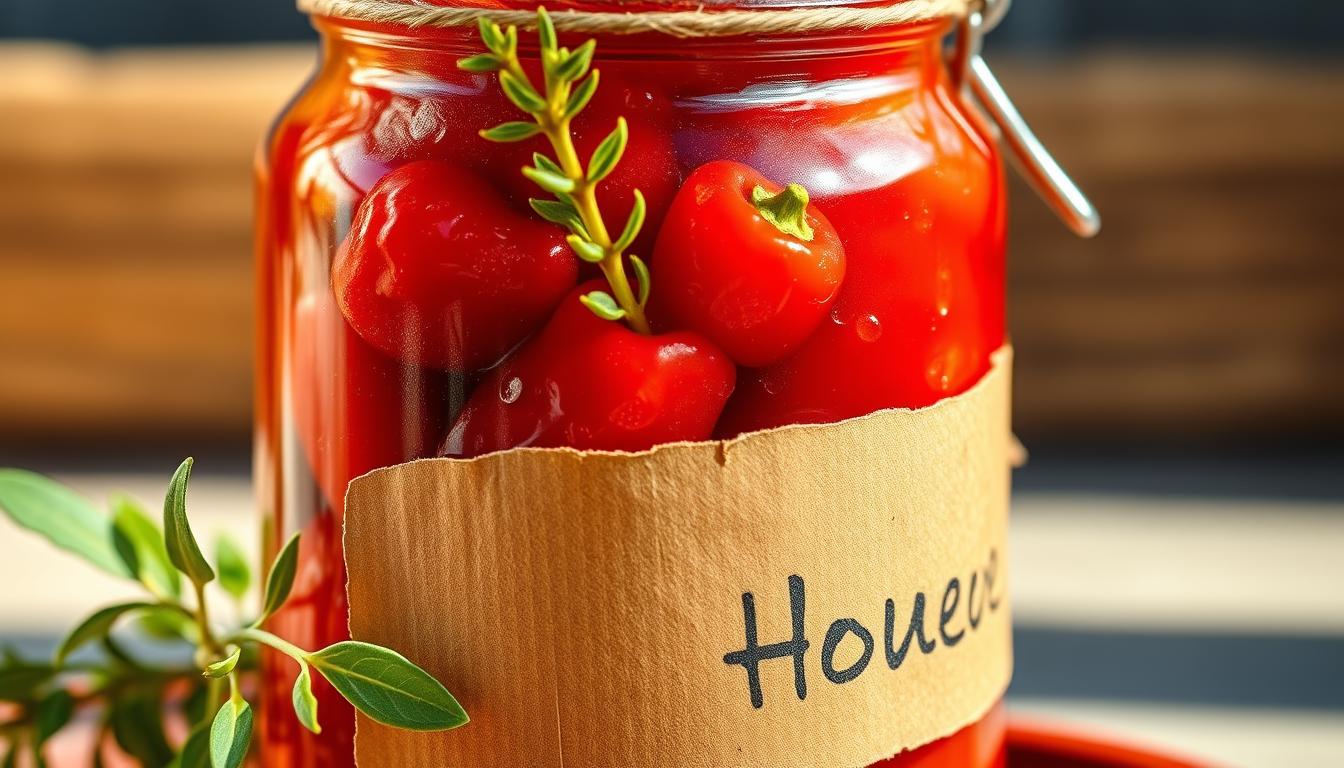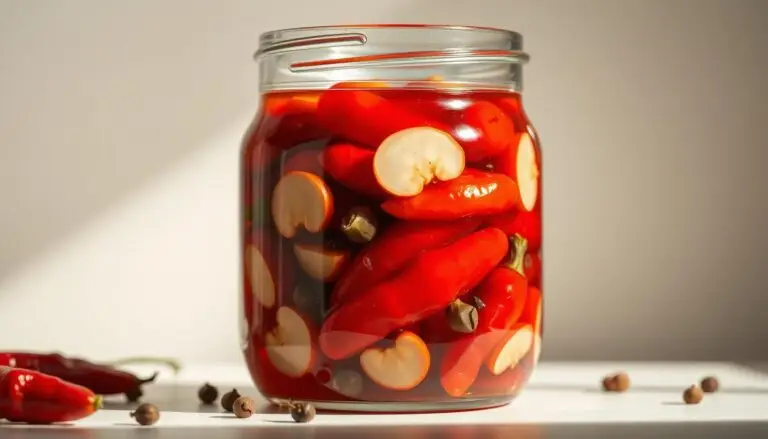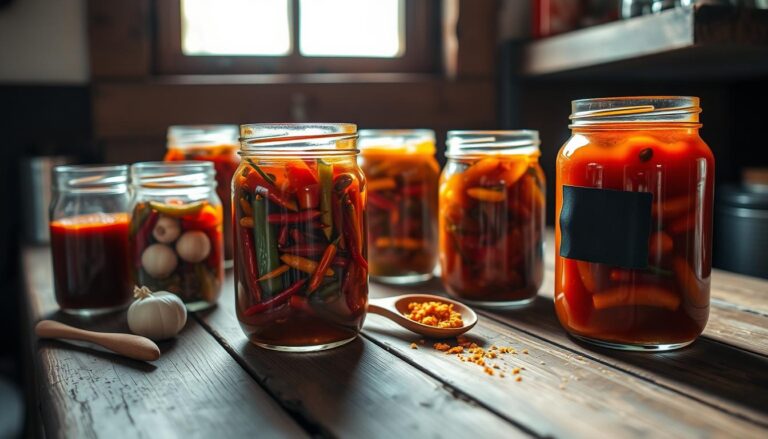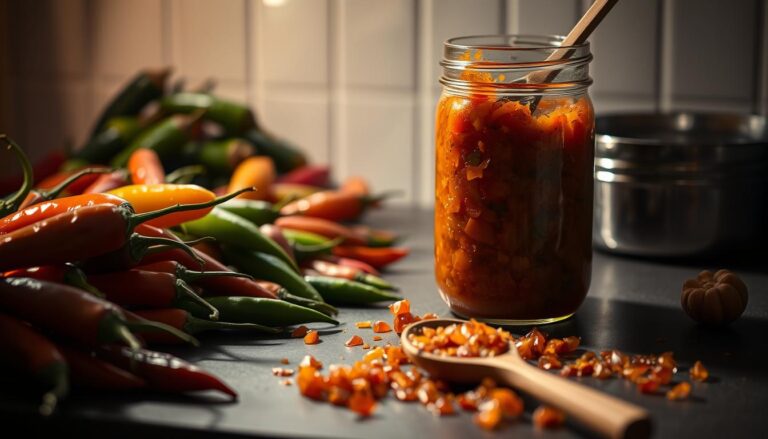Fermented Pepper Sauce Recipe: Easy Instructions for Homemade Sauce
Table of Contents
Explore the world of homemade hot sauce with this ultimate fermented pepper sauce recipe. Making your own fermented hot sauce is more than just cooking. It’s a journey to discover intense flavors and health benefits in your kitchen.
A true fermented pepper sauce is different from store-bought ones. It uses lacto-fermentation to turn fresh serrano peppers into a tangy, spicy condiment. These peppers have a Scoville Heat Unit of 10,000 to 23,000.
By making your own hot sauce, you control every ingredient. Just 20 minutes of prep work can result in a sauce that’s full of flavor and health benefits. The fermentation process adds a depth of taste that store-bought sauces can’t match.
If you love spice or are just starting to explore cooking, this recipe will take your skills to the next level. It turns ordinary peppers into an amazing condiment that will wow your loved ones.
Understanding Fermented Hot Sauce Basics
Exploring fermented hot sauce is like entering a world of culinary magic. It turns simple peppers into a spicy delight with rich flavors. This process is not just cooking; it’s a science that makes food taste better and healthier.
Benefits of Fermentation for Hot Sauce
Fermentation is a game-changer for homemade hot sauce. It’s a natural way to keep food fresh and add flavor. Here are the main perks:
- Develops deeper, more complex taste
- Increases probiotic content
- Enhances pepper’s natural sweetness
- Reduces extreme spiciness
The Science Behind Lacto-Fermentation
Lacto-fermentation is a cool science where good bacteria turn peppers into something special. These microbes eat sugars and make lactic acid. This acid keeps the sauce fresh and flavorful.
| Fermentation Parameter | Recommended Range |
|---|---|
| Temperature | 60-75°F (16-24°C) |
| Salt Ratio | 4 tablespoons per quart of water |
| Fermentation Duration | 1-5 weeks |
Key Differences from Store-Bought Sauce
Your homemade fermented hot sauce is different from store-bought ones. Lacto-fermented sauces have deeper flavors, live probiotics, and a more balanced heat. They’re better than vinegar-based sauces in many ways.
- Naturally preserved without added vinegar
- Rich in beneficial bacteria
- More complex flavor development
- Potential health benefits from probiotics
Learning about fermentation basics can turn your hot sauce into a gourmet treat.
Essential Equipment and Ingredients
Making your own fermented pepper sauce needs the right tools and ingredients. Knowing what equipment to use helps you make a tasty DIY pepper sauce. This sauce can add special flavors to your dishes.
Necessary Equipment for Fermenting Peppers
- Quart-sized glass jars with tight-fitting lids
- Fermentation weights to keep peppers submerged
- Waterproof fermentation tray
- Clean tea towel
- High-powered blender
- Glass bottling containers
Having the right setup is key for making a flavorful DIY pepper sauce. Good equipment keeps your sauce safe and helps it ferment well.
Key Ingredients for Fermented Hot Sauce
| Ingredient | Quantity | Purpose |
|---|---|---|
| Sweet Peppers | 3 oz | Adds sweetness and depth |
| Hot Peppers | 18 oz | Provides heat and primary flavor |
| Sea Salt | 1 Tbsp | Facilitates fermentation |
| Filtered Water | 2 cups | Creates brine solution |
| Apple Cider Vinegar | ¼ cup | Enhances tanginess |
Using top-notch ingredients is vital for great fermented hot sauce. Fresh, whole peppers are best for deep, rich flavors.
“The secret to amazing fermented hot sauce is patience and quality ingredients.” – Fermentation Expert
Temperature is very important for fermentation. Keep it between 55°F to 75°F for two weeks. This temperature helps bacteria work well and brings out the best flavors.
Preparing Your Peppers for Fermentation
Starting a tasty homemade fermented condiment begins with preparing your peppers right. Your hot sauce recipe’s success depends on picking and handling peppers carefully and safely.
Safe Handling of Hot Peppers
Hot peppers have capsaicin, which can irritate your skin and cause burning. Here’s how to stay safe:
- Always wear disposable gloves during pepper preparation
- Work in a well-ventilated area
- Avoid touching your face or eyes
- Wash hands thoroughly after handling
Proper Cleaning and Cutting Techniques
To prepare peppers for your homemade fermented condiment, follow these steps:
- Rinse peppers under cool running water
- Pat dry with clean paper towels
- Use a sharp knife for precise cutting
- Cut peppers on a dedicated cutting board
Seed Removal Options
Removing seeds affects your hot sauce’s heat level. Here are your options:
- Mild sauce: Remove all seeds and membranes
- Medium heat: Keep some seeds
- Extra hot: Leave most seeds intact
Pro tip: Choose thick-walled peppers like jalapeños for better texture during fermentation. For the best results, pick fresh, firm peppers without blemishes.
Fermented Pepper Sauce Recipe
Making your own fermented pepper sauce is a fun journey. It turns simple ingredients into a vibrant, probiotic hot sauce. This recipe will help you make a tasty condiment full of complex flavors and healthy bacteria.
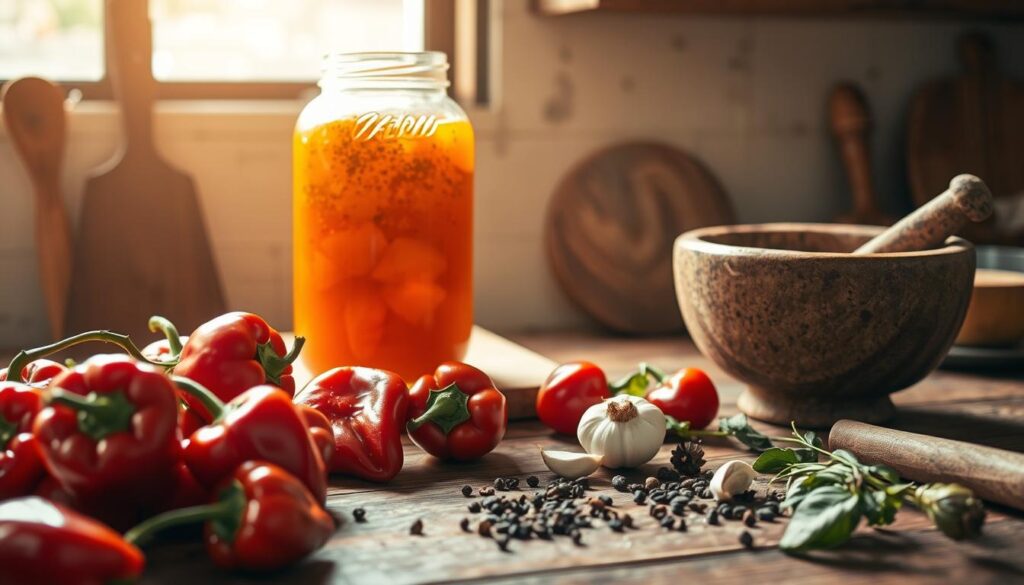
To start your fermented hot sauce adventure, gather these ingredients:
- Fresh peppers (mix of Anaheim and Serrano)
- Green tomatoes
- Onion and garlic
- Kosher salt
- Filtered water
The secret to a great probiotic hot sauce is in the prep. First, weigh your pepper mix and figure out the salt amount. Pro tip: Multiply the total weight by 0.02 to find the exact salt needed.
| Ingredient | Measurement Method | Fermentation Impact |
|---|---|---|
| Salt | 2% of total ingredient weight | Prevents harmful bacteria |
| Water | 1 tbsp salt per 1 cup lukewarm water | Creates optimal brine environment |
| Fermentation Time | 7-21 days | Develops complex flavors |
When chopping peppers, wear gloves. Then, mix the salt into the peppers for 2-3 minutes until they release juices. Put the mix in a sterilized 1-liter jar, making sure peppers are fully covered.
While fermenting, open the jar every day to let gases out. After 3-5 days, you’ll see a bubbly, tangy change. Your probiotic hot sauce can last up to a year in the fridge, adding flavor to your meals.
The Fermentation Process Explained
Lacto-fermentation turns your pepper sauce into a rich, probiotic condiment. It’s more than just pickling. It adds flavor and nutrition with helpful bacteria.
To understand fermentation, you need to know a few key things. These factors affect the taste and quality of your sauce.
Optimal Fermentation Conditions
For the best fermentation, you must control a few important things:
- Temperature: Keep it at 70°F (21°C)
- Salt concentration: Use 3.5% brine
- Vessel: Choose glass or ceramic
- Oxygen exposure: Keep air out
Monitoring and Maintenance Tips
To ferment hot sauce well, you must watch it closely and take care of it. Here’s how:
- Do daily jar burping to let pressure out
- Look for signs of good fermentation
- Be alert for mold
- Keep the temperature steady
| Fermentation Stage | Duration | Key Indicators |
|---|---|---|
| Initial Fermentation | 1-2 weeks | Bubbling, slight color change |
| Active Fermentation | 2-4 weeks | Strong bacterial activity |
| Final Stage | 4-6 weeks | Developed flavor, reduced bubbling |
Troubleshooting Common Issues
Some problems during fermentation can be fixed with the right steps. Mold means contamination, and bad smells are due to wrong salt or temperature. Always use your senses and throw away anything that looks or smells off.
Creating the Perfect Consistency
Getting the right texture is key when making your own pepper sauce. The blending stage turns your fermented peppers into a tasty homemade hot sauce. It has the perfect feel and flow.
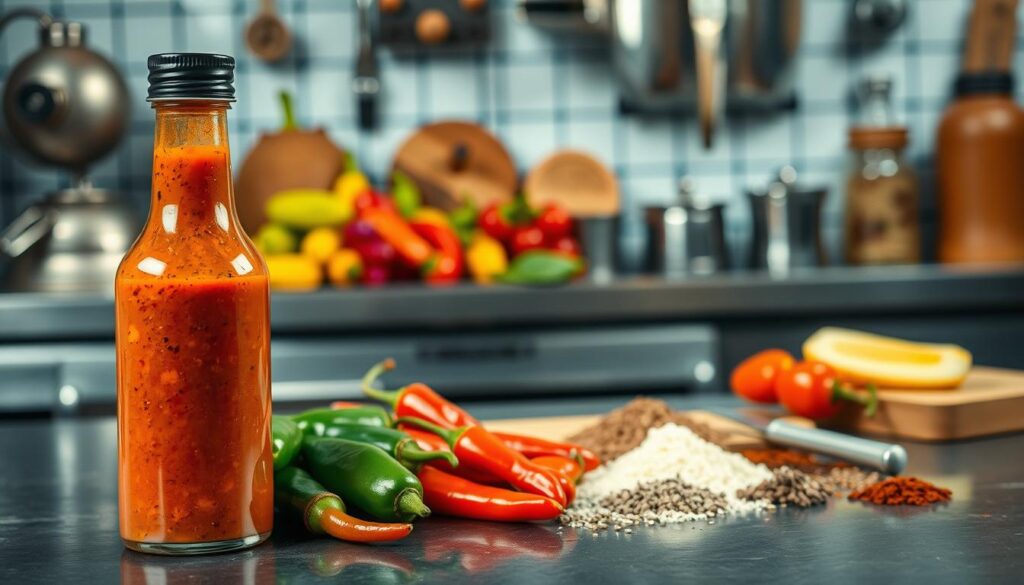
Your journey ends in the blending stage, where you decide the final texture. Here are some tips to make your homemade hot sauce just right:
- Strain the fermented peppers, keeping the flavorful brine
- Choose your blending style:
- Smooth puree for a silky texture
- Chunky blend for a rustic feel
- Add the reserved brine slowly to adjust the thickness
“The secret to great DIY pepper sauce is finding your perfect consistency.” – Hot Sauce Artisan
Here are some tips for adjusting your homemade hot sauce’s texture:
| Consistency Goal | Blending Technique | Brine Addition |
|---|---|---|
| Ultra-Smooth | High-speed blender | More brine |
| Slightly Chunky | Pulse blending | Less brine |
| Thick Sauce | Minimal blending | Minimal brine |
You can also add ingredients to improve your sauce’s texture:
- Xanthan gum (1/2 teaspoon): Thickens without changing flavor
- Honey or maple syrup (1 tablespoon): Adds body and a hint of sweetness
Remember, your DIY pepper sauce is all about your taste. Keep trying until you get the perfect consistency for you!
Flavoring and Customization Options
Making a spicy condiment is a fun journey. Your homemade fermented condiment can go from simple to gourmet with a few tweaks. This turns it into a flavor experience like no other.
Great homemade fermented condiments start with balancing flavors. It’s all about trying out ingredients that match your pepper mix.
Additional Ingredients for Enhancement
Here are some ingredients to boost your spicy condiment’s flavor:
- Fresh herbs like cilantro (up to 1/4 cup)
- Citrus elements such as lime juice (2 tablespoons)
- Fermentation enhancers like kombucha vinegar (2-3 tablespoons)
- Fruits for a touch of sweetness
- Aromatic spices
Heat Level Adjustments
Your heat preference can change the sauce a lot. Peppers come in different heat levels:
| Pepper Type | Heat Level | Flavor Profile |
|---|---|---|
| Jalapeño | Mild to Medium | Grassy, bright |
| Serrano | Medium to Hot | Sharp, crisp |
| Habanero | Very Hot | Fruity, intense |
| Scotch Bonnet | Extremely Hot | Sweet, Caribbean-style |
Balancing Flavors
Getting the perfect balance in your condiment is key. Use about 2.3% salt by weight in your mash. This means 1 teaspoon of salt per pound of peppers.
Remember, the fun is in trying new things. Mix different peppers and ingredients to make a sauce that’s all you. It’s a way to show off your taste.
Storage and Preservation Methods
After making your perfect fermented pepper sauce, it’s important to store it right. Clean glass bottles are best for keeping your homemade hot sauce fresh. Make sure to sanitize these containers well before filling them with your sauce.
Keeping your sauce in the fridge is key to its longevity. Your fermented sauce can stay good for up to a year in the cold. But, always check for mold, as it means you need to throw the whole batch away to stay safe.
The good bacteria in your sauce stay active even after it’s chilled. This makes your homemade sauce a healthier choice than store-bought ones. Always use clean tools when serving to keep the sauce safe and fresh.
To keep your sauce at its best, store it in the coldest part of your fridge. This is usually the back, where it’s cooler. A tight lid is also important to keep the flavors in and prevent them from getting lost.
Chef’s Tools Recommended for Fermenting Peppers:
- Digital kitchen scale
- High-powered blender
- Food processor
- sharp chef’s knife
- Wide-mouth mason jars
- Digital pH meter
- Fermentation weights
- Airlocks
- Waterproof fermentation tray
- Clean tea towel
Check This For More Homemade Fermenting Hot Sauce Recipes

